Book: Health and Fitness
Author: Nayma Nishat - Researcher, Health & Fitness
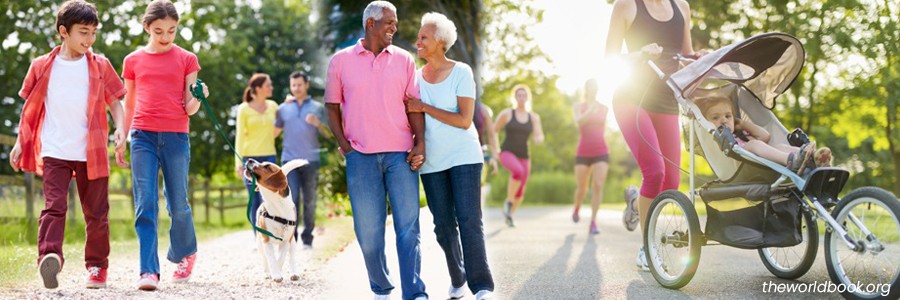
“In order for man to succeed in life, God provided him with two means, Education and Physical Activity.” ― Plato
Regular physical activities not only make you feel good about yourself but also can improve your health and reduce the risk of developing several types of Physical Health Issues. For example, heart disease, stroke, high blood pressure, diabetes or asthma, many cancers, type 2 diabetes, and osteoporosis, etc.
There are many ways you can add physical activity to your healthy lifestyle, no matter how old you are and what is your activity level. Physical activity can be fun or relaxing and you can do it on your own, or with your friends or groups of other people with similar health goals.
Whether you want to try your first yoga class or do active chores around the house, yard work, or walking the dog, physical activities can play an important role in your health and wellness.
Physical activity refers to any body movement that occurs by contraction of skeletal muscles and that produces substantial increases in the body’s energy consumption relative to being at rest.
According to WHO,
“Physical activity has significant health benefits for hearts, bodies, and minds. People who are insufficiently active have a 20% to 30% increased risk of death compared to people who are sufficiently active.”
“Physical activity contributes to preventing and managing noncommunicable diseases such as cardiovascular diseases, cancer, and diabetes.“[1]
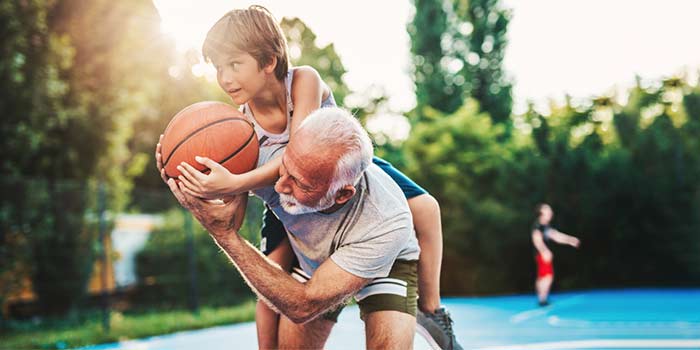
Common examples of physical activity are moving around, clapping, shopping, going upstairs, household chores like scrubbing, cleaning windows or chopping garlic and a long, etc.
Some activities require more energy expenditure than others. Typing in an office is not the same as carrying bags on site. Still, do not confuse any of these with physical exercise itself. Let’s know more about different types of physical activities.
Health is correlated with quality of life. Physical fitness is one of the Key Aspects of Physical Health. If you get regular physical activity, you can improve and also maintain your physical fitness as well as your health in general. It can include:
1. Everyday Physical Activities: For example, walking or cycling, doing housework, swimming, gardening, shopping washing your car, or any active or manual work that you can do as part of your job.
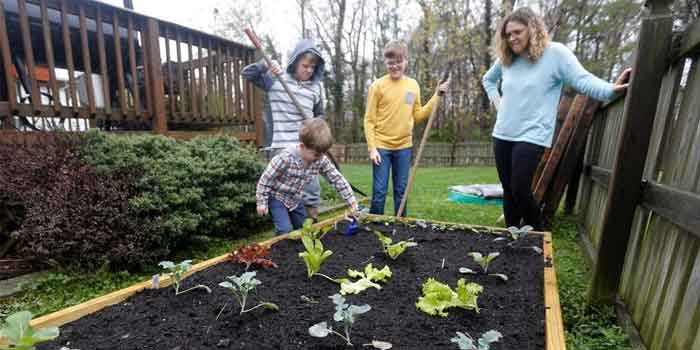
2. Recreational Physical Activities: This includes physical activities such as dancing, active play amongst children, or climbing, hiking, cycling, or skipping with a rope for recreation.
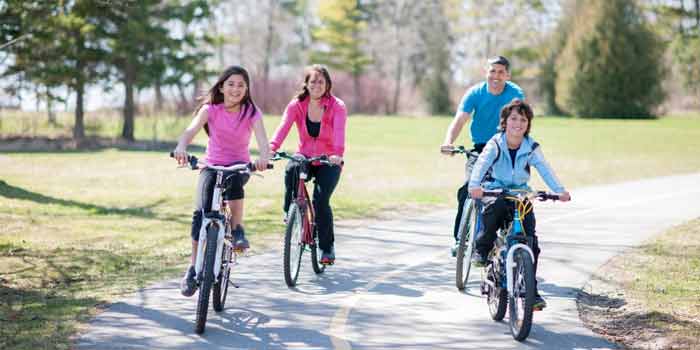
3. Sport and Exercise: For example, exercise and fitness training at a gym or during an exercise class, doing Aerobic activities, yoga and Pilates, Muscle-strengthening activities or swimming, and competitive sports such as football, rugby, basketball, squash, tennis, etc.
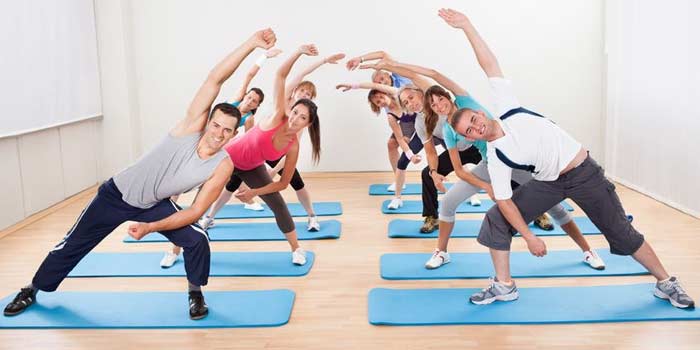
American infectious disease and public health expert, Thomas R. Frieden says, you should do “Physical activity – even if you don’t lose an ounce, you’ll live longer, feel healthier and be less likely to get cancer, heart disease, stroke, and arthritis. It’s the closest thing we have to a wonder drug.” [2]
So, try to be active every day, in as many ways as possible. Aim for at least 2 ½ hours of moderate (or 1 ¼ hour of vigorous physical activity) spread throughout the week.[3]
However the more you do, the greater your health benefit.
Experts tend to describe physical activities in three ways: Light, Moderate, and Vigorous.
Light exercise includes activities that do not cause you to break a sweat or produce shortness of breath. For example, slow walking, cooking food, child care, mild stretching, etc.
Moderate-intensity activity means an activity that makes you breathe a bit faster, notice your heart beating faster, and feel a bit warmer – for example, walking briskly, swim leisurely, ballroom dance, etc.
And Vigorous-intensity activity will usually make you breathe very hard, so you feel short of breath, make your heartbeat quickly, and mean you will be unable to carry on a conversation – for example, running or jogging, cycling fast, hiking, or Swimming moderately to hard.
Besides these, aerobic, flexibility, and muscle-strengthening activities are really helpful to improve your Physical Health.
The Physical Activity Pyramid is a visual guide that helps people to know what daily activities and sports they can do to have a healthy lifestyle, what activities to do on a daily basis, and which can have a weekly or less frequency.
The Pyramid of Physical Activity was created by the Park Nicollet Medical Foundation, an American foundation in defense of a healthier life. It is based on the model of the Food Pyramid.
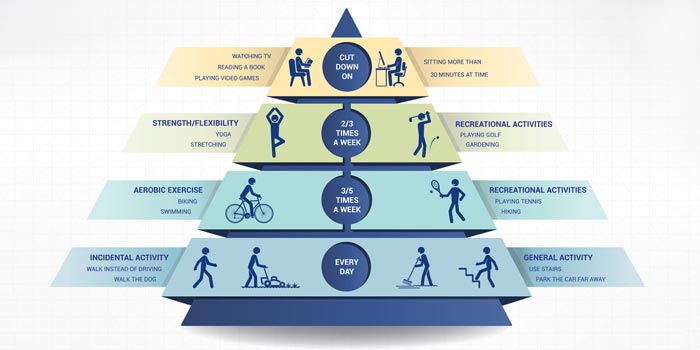
The pyramid of physical activity also shows us in a graphic way and at a first glance how to combine the different types of physical activity to achieve an active and healthy lifestyle. The purpose of the physical activity pyramid is to provide us with a guide to gradually introduce physical exercise into the daily lives.
Here we show you the Pyramid of Physical Activity so that you can plan your physical activities properly.
The first recommendation for your children to start implementing the physical activity pyramid in their lives is to avoid inactive periods of more than two hours during the day. This includes watching TV, playing computer games, surfing the Internet, or any other sedentary activity. It’s not that you can’t spend time on the activities outlined above. Rather, it’s about limiting the number of hours we spend on them.
According to international recommendations presented by experts worldwide, children and adolescents must perform at least 60 minutes of physical activity daily. This should be of moderate to vigorous intensity. And, at least two days a week, you should include exercises to improve bone health, muscle strength, and flexibility.
Below I explain the activities recommended in the pyramid through levels. The idea is that the intensity of the activity should be progressively increased.
Once you have been able to understand the meaning of this pyramid, it is time for you to discover the parts that shape it. It must be stated that, from the bottom up, they talk about activities that must be carried out daily, frequently, several times a week, and on specific occasions. It consists of four levels, as shown in the figure.
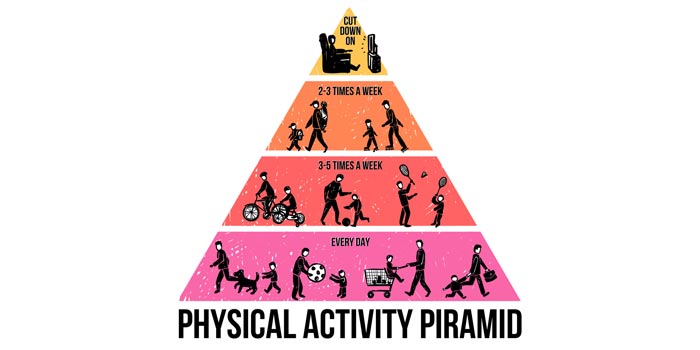
At level 1, which is the base of the pyramid, you should avoid inactive periods of more than 2 hours during the day. At the base, daily activities are recommended, such as walking to school, helping to do the shopping, climbing the stairs at home, or walking the dog.
A second level in which they come to encompass what are activities that should be developed once or twice a week, at least. Specifically, they are sports disciplines that bring benefits such as improving coordination, increasing strength and endurance, increasing dexterity.
This section of the pyramid of physical activity is occupied by what are activities that are established to be carried out several times throughout the week. These are activities, above all, to take place outdoors and that, among other things, will improve the well-being of the little ones.
Children also can do activities of an aerobic nature, such as a light run, gentle swimming, and some sports such as football and basketball.
Advantages to which should be added an increase in self-esteem, an increase in knowledge of one’s own body, and the acquisition of values such as effort and ability to work to achieve objectives.
Although you have already been able to intuit what are the advantages of putting this pyramid into practice and promoting physical activity in children, here are the most significant ones:
The practice of physical exercise is extremely beneficial for the physical and emotional health of minors. Also, it is a very suitable habit to acquire from the first stages of growth. If you can instill in your little one love of sports and physical activity, they will undoubtedly enjoy a much healthier life.
Perform one hour a day of moderate or vigorous physical activity, and two or three times a week strength and flexibility work.
And let’s remember that physical activity is not just doing sport, even if sport implies physical activity. There are physical activities such as walking, running, climbing stairs, playing hide-and-seek in the yard, tagging, cops and robbers, hare, or jumping rope that are excellent physical exercise and can be added to the active exercise of the child throughout the day.
Like the Pyramid of physical activity for children, adults also have a similar one. And there is a lot of discussion about nutritional pyramids, but this concept could also be applied to different types of physical activity. Now I show you the pyramid of physical activity for adults, which graphically shows what that we can do daily to start moving more.
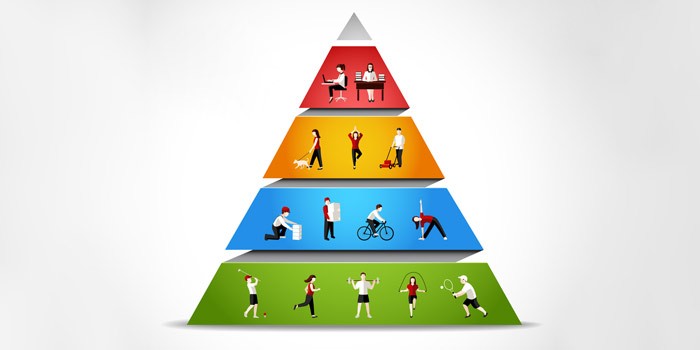
Did you know where on the physical activity pyramid do sedentary activities belong? The very first level of the pyramid is Sedentary activities. There are some activities that we must limit to 2 hours each day, such as sitting down playing video games, watching television, or on the computer.
Limited Activity
At the last level of the pyramid, we find muscle-building exercises and stretching that we can do between two and three times a week. It would be activities of short duration but maximum intensity.
Do at least 2 times a week:
Strength
Flexibility
In the next step, we already see that between three and five days a week we can complement daily activities with aerobic exercises and more intense activities.
We can do squats, push-ups, pull-ups, and other similar exercises.
It is recommender to do,
At the base of the pyramid is the minimum that must be present every day to lead an active life. Did you know where on the physical activity pyramid do lifestyle activities belong?
Activities on the bottom level of the physical activity pyramid include lifestyle activities like walking, swimming, using the stairs instead of an elevator, etc.
Do these types of physical activities as often as possible.
Seeing the guidelines graphically is very useful to understand what, how much and how often we should move with different activities.
We have many options to move more, therefore, I suggest that we start with every day, usually located at the base of the pyramid and that will help us to move away little by little from a sedentary lifestyle that affects health so much.
Health authorities are increasingly stressing the importance of frequent moderate physical exercise. Not only because it helps fight overweight, but also because it is good for overall health. And it is something that many of us do not take seriously.
If we want to be healthy, what is the minimum amount of physical activities that we must do according to our age? It is a question that has long worried scholars and has reached a certain consensus (something that has not happened in regards to nutrition).
Mayo Clinic exercise researcher Michael J. Joyner in the New York Times, most people will burn about 1,000 calories a week. If we add to this, besides, the physical activity that we perform in an unplanned way (walking to work, climbing stairs, walking the dog …) we will burn about 2,000 calories a week. According to Joyner, once this number is reached, it is positive to do more exercise, but “the added health benefits stabilize after that figure.”[4]
Let’s know more.
Physical activity for under 5 year’s old children is not necessary as it comes naturally. But it is still important to allow young children to play, particularly through floor-based play and water-based activities during their bath in safe environments.
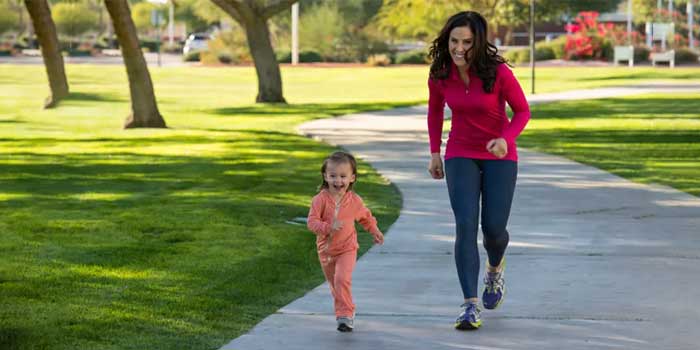
And Children who are capable of walking should be physically active daily for at least 180 minutes throughout the day.
For children and young people, physical activity includes play, games, sports, transportation, chores, recreation, physical education, or planned exercise, in the context of family, school, and community activities.
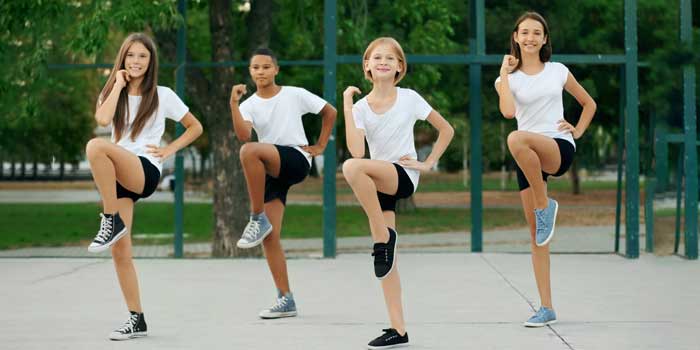
Children and youth aged 5–17 should accumulate at least 60 minutes of moderate- to vigorous-intensity physical activity daily. Most of the daily physical activity should be aerobic. Vigorous-intensity activities should be incorporated, including those that strengthen muscle and bone, at least 3 times per week.[5]
In adults aged 18–64, physical activity includes leisure-time physical activity (for example walking, dancing, gardening, hiking, swimming), transportation (e.g. walking or cycling), occupational (i.e. work), household chores, play, games, sports or planned exercise, in the context of daily, family, and community activities.
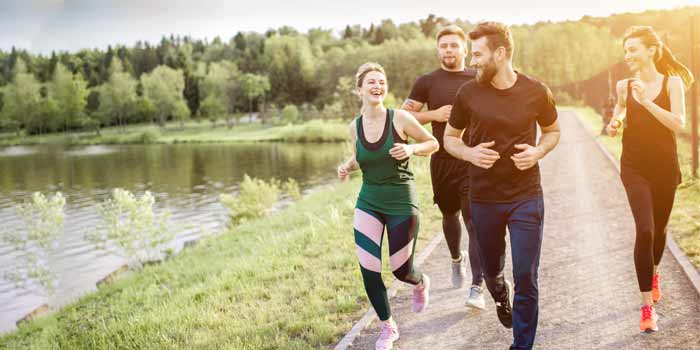
It improves cardiorespiratory and muscular fitness, bone health, reduces the risk of NCDs and depression.
Adults aged 18–64 should do at least 150 minutes of moderate-intensity aerobic physical activity throughout the week or do at least 75 minutes of vigorous-intensity aerobic physical activity throughout the week or an equivalent combination of moderate- and vigorous-intensity activity. Muscle-strengthening activities should be done involving major muscle groups on 2 or more days a week.[6]
In adults aged 65 years and above, physical activity includes leisure-time physical activity like walking, dancing, gardening, hiking, swimming and occupational (if the individual is still engaged in work), household chores, play, games, sports or planned exercise, in the context of daily, family, and community activities.
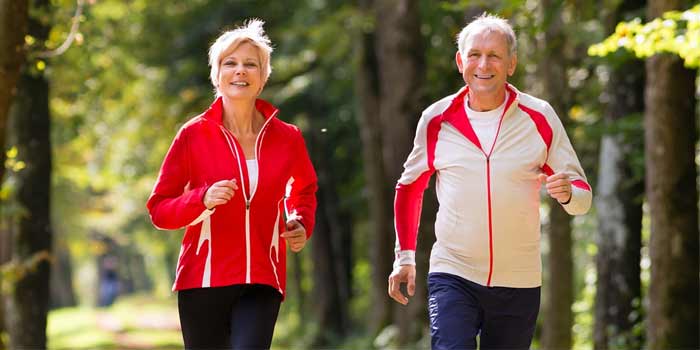
Older adults should do at least 150 minutes of moderate-intensity aerobic physical activity throughout the week or do at least 75 minutes of vigorous-intensity aerobic physical activity throughout the week or an equivalent combination of moderate- and vigorous-intensity activity.
Older adults, with poor mobility, should perform physical activity to enhance balance and prevent falls on 3 or more days per week. Muscle-strengthening activities, involving major muscle groups, should be done on 2 or more days a week. When older adults cannot do the recommended amounts of physical activity due to health conditions, they should be as physically active as their abilities and conditions allow.[7]
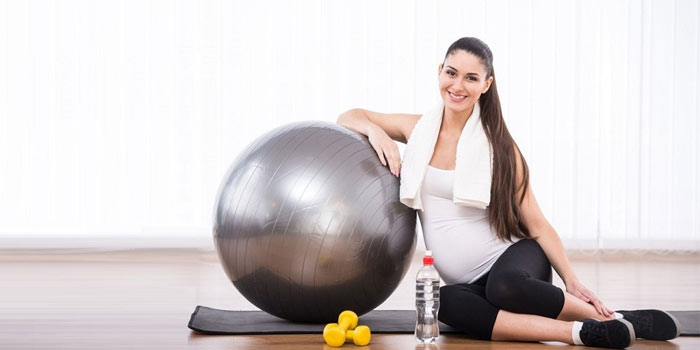
According to the 2008 Physical Activity Guidelines for Americans—
If you want to start doing exercise to improve your health during your pregnancy, you should start very slowly, carefully, and gradually. Just listen to your body because your body will naturally give you signals about everything is ok or it is time to reduce the level of exercise you are performing.
It is important that people with disabilities continue to train at home since the practice of any physical activity is stimulation, which becomes perseverance, patience, strength, and ability to self-recognize.
The realization of physical activity throughout life is essential to be healthy because it causes health improvements at the physiological level and contributes to psychological well-being.
When children and young people have a motor disability, their ability to move is compromised, at least efficiently and effectively, but it does not mean that they should abstain from physical activity or sports.
The absence of activity in this population can have negative effects on a cognitive level and on their social development. It has been shown that children who are given more opportunities to be mobile tend to be less likely to develop a passive personality or have a “can’t do it” attitude.
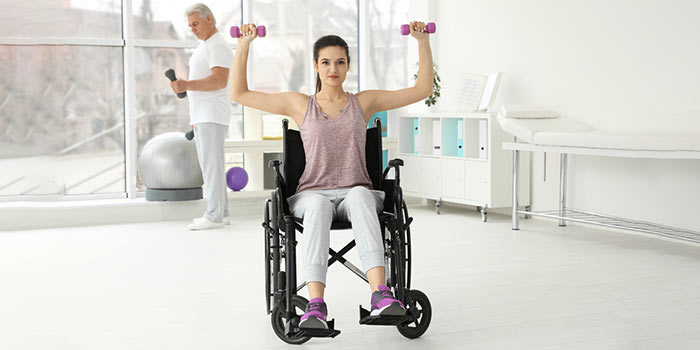
According to a study by the Georgetown University “Center for Child and Human Development Inclusive Fitness Coalition” in the USA, people with disabilities are almost three times more likely to be sedentary than individuals without disabilities (29% vs. 10%).
Almost 56% of people with disabilities do not engage in any physical activity, compared to 36% of people without disabilities. Only 23% of people with disabilities are active for at least 30 minutes, three or more times a week.
About 1.5 million students in public elementary and secondary schools with physical disabilities are excluded from participating in athletic competitions. This means that people with disabilities have been excluded from many health promotion efforts.
The physical activity in children and youth with disabilities (cerebral palsy, neurological syndromes, rare diseases, spinal cord injury, as an intellectual, as a combined both with physical disabilities) should be promoted early and often, while the nervous system and muscle system -Skeletal have greater neuroplasticity.
The muscles of children with disabilities must maintain flexibility and strength, the bones need compression load in a way that is as similar as possible to how it occurs in children with typical development.
The heart and lungs need to be exercised moderately to maintain optimal endurance and function. In some pathologies, the muscles and bones do not develop completely and the aging process for all individuals involves a gradual decrease in muscle strength, elasticity, and bone density, being particularly devastating in people with motor disabilities, since they may have other compromised areas.
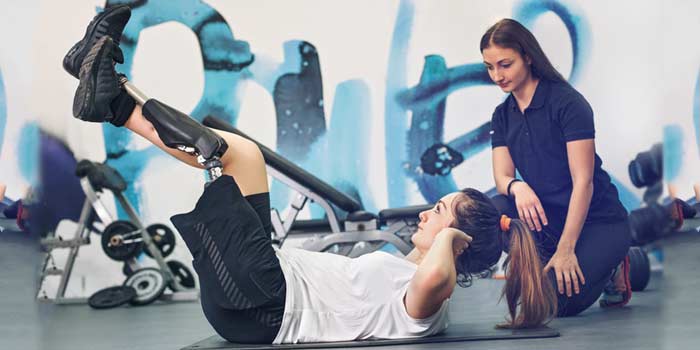
It has been shown that physical activity relieves pain, prevents the appearance and progression of deterioration and functional limitation; restores, maintains, and promotes general fitness.
The key to these benefits is found in prolonged physical activity, which can be carried out with therapy programs focused on formulating recommendations that promote a more active lifestyle, outside the clinical level and adjusting to particular needs.
Young people with physical disabilities who have had the opportunity to do constant physical exercise or a sport in particular express that thanks to these activities they feel totally included and valued. As in any collective sport, companionship is greatly encouraged, they learn to manage their emotions in competition and the ability to excel, etc.
In addition, there are family benefits, since they have the possibility of exchanging information between parents who are starting in this new stage (the beginning of a physical activity/ sport for their child) with those who have more experience. This implies emotional support among family members and contributes to the normalization of disability.
This requires joint work, coordinated between the different professionals in the field of health, physical activity and recreation.
It is clear that physical activity is good for the health of people with disabilities, specifically those who live with a physical motor disability.
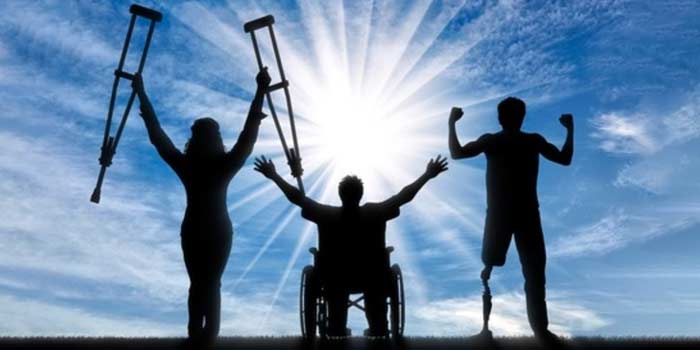
In this section, I want to highlight the benefits of physical activity for people with disabilities.
With an exercise routine you will not only strengthen your body parts, you will be able to stay active by balancing your mode, emotions and, contributing greatly to your physical health.
Remember that a healthy mind and a healthy body are unstoppable!
Read more about the other Benefits of Physical Activity.
If you decide to practice a physical activity, it is necessary to take a simple step. You can simply stay active the rest of the day: take a walk. Walking is a good alternative for most people. It is recommended that at the beginning of the activity you take a rhythm that allows you to talk while you walk. It’s easier and more fun to go for a group walk.
If you still confused about how to start, try increasing your physical activity like this:
1. Spend more time on everyday things that involve moving around and enjoying yourself: Walking, pruning the garden, cleaning the house, it all adds up!
2. Walk more! Try to do it in blocks of at least 10 minutes, until you complete 30 total. For example, if you are a housewife; walk to go to the market, the store, the supermarket.
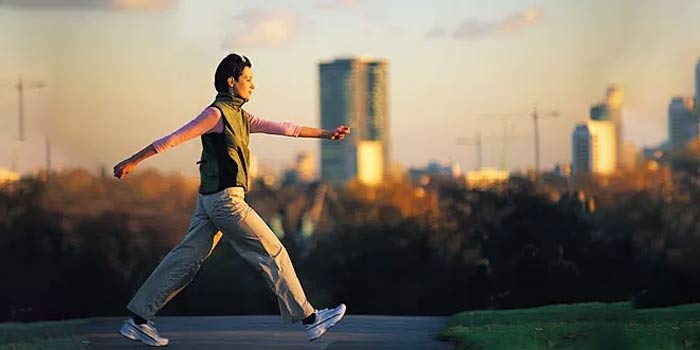
Even if it seems not very functional, instead of going only once; do it several times – if it’s walking – walk a few extra blocks, take the longest path or take new routes (that even helps your thinking structure get stimulated and be more creative).
3. Instead of coming home and going to bed; Choose to walk at least 15 minutes a day to start. Surely you have that time and dedicate it to things – just as important perhaps – but that does not benefit your health like the internet or TV!
4. If you can’t resist “watching” at least 1 episode a day on Netflix, while you watch it:
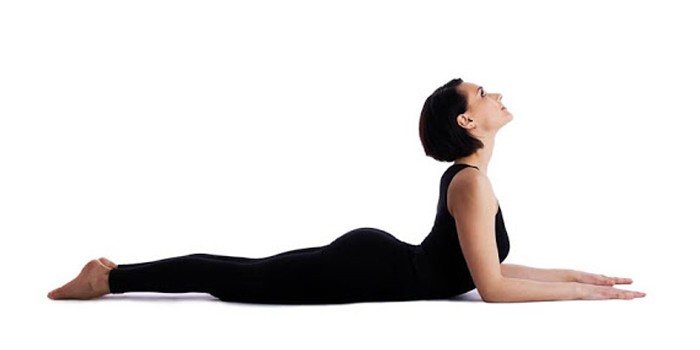
5. Make your social activities on the go! Instead of going for a coffee or lunch and sitting talking for 2 hours, change it or combine it with a walk-in a mall, museum, park, or fun places.
6. In the office:
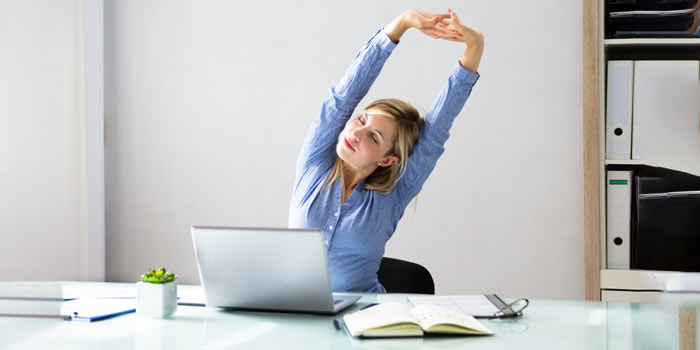
7. At home:
Now, there are no excuses! Any move is good. Even if you don’t fully meet the recommendations, remember that doing some physical activity is better than doing nothing.
Let’s know more about the physical activities at home.
There are no excuses. Physical activity has many physical and psychological benefits. Besides, it prevents cardiovascular diseases and various types of cancer, among many others.
You do not need to join any gym or school, a more comfortable and practical option is to exercise at home.
Next, I will show you 10 physical activities that you can do simply at your home.
Who has not ever danced alone or with his partner in the apartment? It is a very entertaining aerobic activity.
In addition to coordination, the cardiorespiratory system is worked, obtaining energy through the oxidation of fats (if it is carried out for a long time and at a low intensity).
Everyone can do this exercise at home. It is an intense activity that helps to strengthen the legs.
As it is an intense exercise, you will burn many calories, so you will tone your figure.
Try not to use the elevator to go up to your apartment. Going up and downstairs is a good way to strengthen your lower muscles.
If you carry shopping bags or other cargo, try to keep your back straight. Proper posture will prevent injuries that can worsen over time. You can also try this stair workout for weight loss.
It is an exercise to strengthen the legs, especially the quadriceps.
Try to keep your back straight and that your knees do not exceed the tips of your feet, this will avoid injuries.
If you are a beginner, you can start by resting your knees on the mat/towel. When you have acquired more practice you can do them by supporting your feet. It is an excellent exercise to do at home and to strengthen the upper body.
This is an awesome exercise. With only your forearms and feet resting on the floor, you will have to hold for several seconds in this position with your back straight and your abdomen contracted.
You will strengthen the core and give stability to your body. It will help you prevent injuries.
Let’s continue with another isometric exercise. You will have to support your head, scapulae, and feet on the ground. The goal is to raise your pelvis as high as you can and hold it in that position for several seconds. In this way, you will strengthen the lower posterior muscles (glutes and hamstrings).
If you don’t have dumbbells you can use water bottles. With the elbows close to our body and without moving them, perform the flexion-extension of the arms.
It is a fantastic exercise to strengthen the muscles of the arms and specifically the biceps.
Raising the elbows to the height of the shoulders and forming an angle of 90º with the arm. Try to bring the scapulae (or shoulder blades) together by throwing the shoulders back and down.
You have to do several repetitions (10-15). This exercise serves to strengthen the paravertebral muscles and contribute to a correct posture, which will prevent injuries.
It is an exercise to strengthen the muscles of the pelvic floor. Lying on the floor you will have to contract and raise the muscles of the vagina and hold for several seconds.
Later you should return to the starting position and relax. It will help you control urinary or fecal incontinence, help childbirth and improve sexual relations.
Now we just have to practice these activities regularly. Over time, once you have mastered the exercises correctly, you will be able to perform variants: increase the number of repetitions/seconds, less rest time, increase the load, etc.
You have already seen that the gym is not necessary, simply with will and effort you will be able to improve your body and therefore your well-being, and with the comfort of being able to exercise at home.
Raising the elbows to the height of the shoulders and forming an angle of 90º with the arm. Try to bring the scapulae (or shoulder blades) together by throwing the shoulders back and down.
You have to do several repetitions (10-15). This exercise serves to strengthen the paravertebral muscles and contribute to a correct posture, which will prevent injuries.

If you have not been active at all and have a medical disorder such as heart disease, high blood pressure, diabetes, asthma, or other diseases; then consult your doctor to know the type and the amount of physical activity that is suitable for you.
Here we can see, everyone can enjoy physical activities. Get out of your comfort zone and don’t give your body a chance to get used to a routine. Mix intensities, durations, and training volumes by changing distances, number of sessions, and repetitions. Vary the frequency of the exercises and do intervals in your cardio sessions. Seek efficiency in cardio training also doing workouts with your own weight.
A very important rule that everyone should follow regardless of their fitness level is to never skip a day off. Make sure that you take a break from all your fitness activities at least once a week.
So choose the activities which are best for you. And LET’S GET ACTIVE!
References:
© 2022 The World Book. All Rights reserved.
Founder: Nayma Nishat